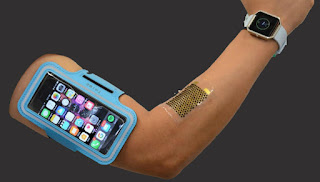Gravitate Science, in this blogger you will find helpful science articles like amazing facts, technology article and many more
Our sweat can power wearable device
Scientists have created stretchable energy units that concentrate vitality from sweat and are fit for controlling gadgets, for example, LEDs and Bluetooth radios.
In a paper, distributed in the diary Energy and Environmental Science, the scientists portrayed how they associated the biofuel cells to a uniquely crafted circuit board and exhibited that the gadget could control a LED while a man wearing it practiced on a stationary bicycle.
The biofuel cell that the Engineers from the University of California San Diego in the US created can extend and flex, adjusting to the human body.
The exploration drove by Professor Joseph Wang, who coordinates the Center for Wearable Sensors at the college, utilized a blend of cunning science, propelled materials and electronic interfaces.
The analysts clarified that biofuel cells were outfitted with a catalyst that oxidizes the lactic corrosive present in human sweat to produce current. This transformed the sweat into a wellspring of energy.
To make the biofuel cells adaptable and stretchable, the architects chose to utilize what they call a "scaffold and island" structure created in Professor Sheng Xu's examination gathering.
Basically, the phone is comprised of lines of specks that are each associated by spring-formed structures.
Half of the dabs make up the cell's anode and the other half are the cathode.
The spring-like structures can extend and twist, making the phone adaptable without disfiguring the anode and cathode.
The reason for the islands and extensions structure was produced by means of lithography and is made of gold.
As a moment step, analysts utilized screen printing to store layers of biofuel materials over the anode and cathode dabs.
The scientists' greatest test was expanding the biofuel cell's vitality thickness, which means the measure of vitality it can create per surface zone.
Expanding vitality thickness is critical to expanding execution for the biofuel cells. The more vitality the cells can produce, the all the more capable they can be.
To expand control thickness, engineers screen printed a 3D carbon nanotube structure on top the anodes and cathodes.
The structure enables specialists to stack each anodic dab with a greater amount of the compound that responds to lactic corrosive and silver oxide at the cathode dabs. Furthermore, the tubes permit less demanding electron exchange, which enhances biofuel cell execution, the investigation said.
Subscribe to:
Post Comments (Atom)
-
How was sahara desered formed ? The Sahara is the world's biggest and most incredible subtropical desert, however information about it ...
-
Scientists have created stretchable energy units that concentrate vitality from sweat and are fit for controlling gadgets, for example, L...




No comments:
Post a Comment